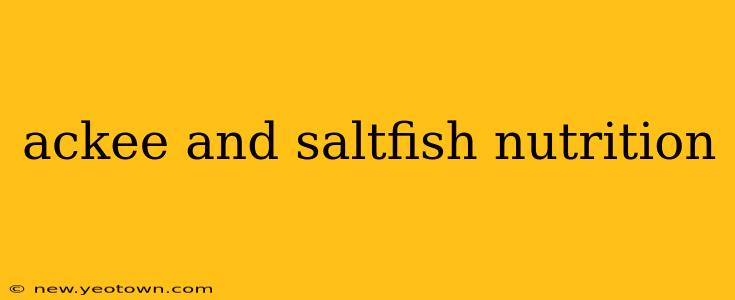Ackee and saltfish—a vibrant, flavorful dish representing Jamaica's rich culinary heritage—is more than just a delicious meal; it's a nutritional powerhouse, packed with essential vitamins and minerals. But understanding its nutritional profile requires a closer look beyond the tantalizing aroma and taste. This isn't just about calories; it's about the balance of nutrients that contribute to a healthy diet. Let's embark on a culinary journey, uncovering the nutritional secrets of this beloved dish.
What are the nutritional benefits of ackee?
Ackee fruit, when ripe and properly prepared, is a surprisingly good source of vitamins and minerals. It's notably rich in vitamin C, a powerful antioxidant crucial for immune function and collagen production. Think of it as nature's shield against free radicals, those harmful molecules that damage our cells. Beyond vitamin C, ackee also provides a decent amount of potassium, an electrolyte essential for maintaining healthy blood pressure and nerve function. It’s a less common but important source of vitamin B6, which contributes to brain development and function. However, it's crucial to remember that only ripe ackee is safe to eat. Unripe ackee contains toxins that can be harmful.
What are the nutritional benefits of saltfish?
Saltfish, or salted cod, presents a slightly more complex nutritional picture. While it's a good source of protein, its high sodium content is a major consideration. Excessive sodium intake can contribute to high blood pressure and other health problems. However, when prepared correctly and consumed in moderation, saltfish can offer valuable nutrients. It's a good source of vitamin B12, essential for red blood cell formation and nerve function, and it's also a source of omega-3 fatty acids, although the amounts depend on how the fish is processed and prepared. Remember that the salting process removes some nutrients, so it's not as nutritionally rich as fresh cod.
Is ackee and saltfish a healthy meal?
The healthiness of ackee and saltfish hinges largely on preparation and portion size. A traditional serving, rich in coconut milk and often featuring other ingredients, can be high in fat and calories. However, by using healthier cooking methods, such as reducing the amount of coconut milk or opting for baked rather than fried versions, you can significantly improve its nutritional profile. The high sodium content of saltfish is also a point to monitor carefully. Balancing the meal with other nutrient-rich foods throughout the day can help mitigate the risks associated with high sodium intake. Moderation and balanced eating are key.
How many calories are in ackee and saltfish?
The calorie count for ackee and saltfish varies considerably depending on the recipe and portion size. A typical serving can range from 300 to 500 calories or more. The addition of coconut milk, oil used for cooking, and other ingredients significantly impacts the overall calorie content. To keep calories in check, consider using less oil, opting for leaner cooking methods, and controlling portion sizes.
What are the potential health risks associated with eating ackee and saltfish?
The primary health risk associated with ackee and saltfish is the high sodium content from the saltfish. As mentioned, this can contribute to high blood pressure. Another risk is the potential for consuming unripe ackee, which contains toxins that can be extremely dangerous. Finally, the high fat content in some versions of the dish should be considered, particularly by individuals watching their cholesterol intake. Always ensure the ackee is ripe and properly prepared before consumption.
Is ackee and saltfish good for weight loss?
Ackee and saltfish, on its own, isn't inherently a weight-loss food. The high calorie and fat content in many preparations can hinder weight-loss efforts. However, mindful preparation and portion control can help. Choosing healthier cooking methods and adjusting ingredients (e.g., reducing coconut milk) can make it a part of a balanced diet designed for weight management. It's crucial to integrate it into a holistic approach to weight loss that includes regular exercise and overall healthy eating habits.
In conclusion, ackee and saltfish, while a delicious and culturally significant dish, requires careful consideration regarding its nutritional impact. By being aware of its potential pitfalls and practicing mindful preparation and portion control, you can enjoy this Jamaican staple as part of a balanced and healthy diet. Remember, understanding the nutritional information empowers you to make informed choices.

